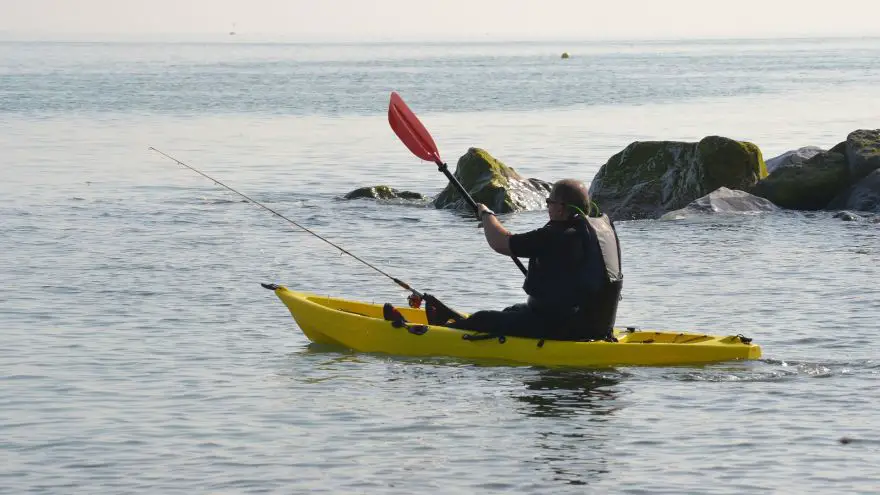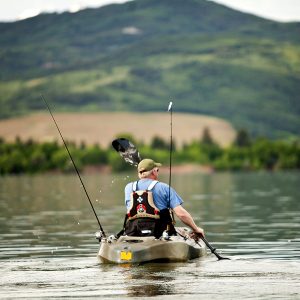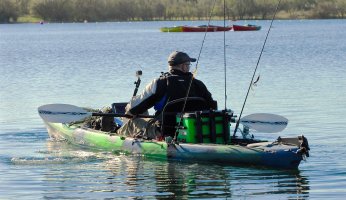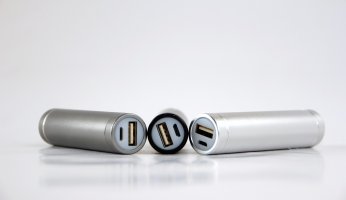Kayak Fishing for Beginners
 Kayak Fishing for Beginners
gearweare.net
Kayak Fishing for Beginners
gearweare.net
Every once in awhile, kayak owners ask themselves if there’s something else to kayaking more than paddling. In fact, there is much more than just paddling: whitewater, swimming, and fishing are one of the activities that can be combined with kayaking to give your paddling experience a bit more fun.
Kayak fishing is practically using the fishing kayaks for what they were invented for. The Inuits, a group of culturally similar indigenous people, habitants of the Arctic regions of Canada, Russia, and the United States, developed this boat more than 4000 years ago with only one purpose, fishing, and hunting during the summer season. Since then, fishing gear and kayaks come a long way and have evolved into more practical items making fishing, in salt or fresh waters, a really pleasant activity that can be enjoyed by anyone.
Fishing on top of a kayak is an activity that is becoming extremely popular in the kayaking world. Kayaking and fishing can be really inexpensive activities that combined, give you tons of fun and relaxing days. Obviously, you need to have your equipment ready to make it a cost-free activity, but once you have your kayak and your fishing gear, the only thing you are going to need is a body of water to put your kayak in and start casting your lines.
Doing both activities, kayaking, and fishing, can be very tricky the first times you do it and if you don’t have the right equipment for it, it can become an activity that you might not enjoy.
Below we will give you all of the information and tips you need to start fishing the next time you go out in the water with your kayak.
The first thing you need to know is what kind of kayak is best suited for fishing but also what kind of kayak will behave best in the type of waters you are going to paddle. The Wilderness Systems Ride 115X Fishing Kayak Review
Kayak fishing can be divided into two categories depending on the water you plan to navigate: Freshwater and Saltwater and these categories are also subdivided into two other categories.
Freshwater references fishing in rivers and lakes while saltwater references the big oceans of the world.
Table of Contents
Freshwater Kayak Fishing
Still waters are those bodies of water that range in all sizes, from small ponds to the great lakes. For fishing on smaller bodies of water, it is recommended to use short and inflatable kayaks that offer a great initial stability with moderate to small levels of rocker and also have great maneuverability so they become the best choice. For this kind of water, recreational and sit on top kayaks are the best choices. Different from small lakes and ponds, fishing on a large body of water requires the angler to paddle long distances to get to the most active fishing spots. Therefore the angler needs longer and slim kayaks, these offer less initial stability and help you out in covering large distances in shorter periods of time.
Moving Waters are the other side of the coin, moving waters can differ from Blackwater rivers clear streams or sedate waters. The first and most important thing when choosing a kayak for this kind of waters is that you need to choose for a kayak with both, great stability and maneuverability as you will have to deal with strong currents and sometimes obstacles. Short and wider kayaks, like the sit on top models, are really good for this kind of fishing, they offer a lot of stability and maneuverability.
Saltwater references to fishing on the oceanic water and can be divided in inshore water or offshore waters.
Inshore waters are those defined as the ones that follow the coastline and have a maximum depth of 70 feet. In this kind of waters, the paddlers are often facing many different water and weather conditions as strong waves or windy days. The best kind of kayaks for fishing in this kind of waters are the long and slim ones, with the moderated level of rocker as they give you more speed and easier tracking over long distances. But the majority of kayak anglers prefer sitting on top kayaks as they are extremely stable and are virtually unsinkable and are extremely easy to get back in case of flipping over, capsizing or being pulled over the kayak by a gigantic monster fish.
Offshore waters are those that ave a minimum depth of 71 feet. Kayak fishing in offshore waters represents a big challenge for the anglers as they usually have to paddle for long distances and have to deal with windy conditions and steep waves that’s why the best-suited kayak for this are long and slim ones with a moderate level of rocker. But surprisingly, again, the most used kayak for this are sit on top kayaks even when larger ones are best suited for this purpose.
What Features should a Fishing Kayak Have?
This is a question commonly asked by people interested in this relatively new sport. And these are some of the features that should be in every kayak with fishing intentions.

First of all, the most important thing that a fishing kayak should have is rod holders. The reason for this is quite obvious when kayaking – unless you have a professional motor-powered kayak – you control the movement of the boat with the paddle that requires you to use both of your hands. If you have already cast your line and desire to move to another location or are doing some trolling fishing or have to deal with rough conditions, being able to put your rod aside to paddle is somewhat of big importance. Some Kayak models special for fishing come with rod holder attachment or built-in ones.
Anchor Systems are definitely a must, when fishing, sometimes you need to stay perfectly still to improve your chances of catching something and will help you out with tides and currents to avoid drifting out. Best recommendations are to use some anchor weighing more than two libs and you can even do it yourself from lead, welded metals and even tying weightlifting weights to a rope.
Paddle Leash. When you are fishing on a kayak, it is very easy to lean to the sides while casting your line or fighting your fish to the surface and when you lean too much you can flip over and lose your kayak paddle and it might be unrecoverable. To prevent you from getting stranded in the middle of a body of water you need to make sure that you’ll never lose your paddle. If you plan on buying a kayak for fishing make sure it features a paddle leash or buy one that can be attached to your boat, that way you’ll never lose your paddle.
Enough Storage Space. When kayak fishing, you need to carry with you much more equipment than when just touring, you’ll be catching fish and will be using a wide set of tools that need to be properly stored to prevent losing your precious items or catch. Nowadays most of the kayaks come with some kind of storage space but you really need something on the large side. Some kayak brands include a floating storage container that can be put inside the kayak or can be pulled behind you to release some space from the dock of your boat.
Safety Tips

One common saying between kayakers reads “Dress to swim and rig to flip” and it means that you must wear appropriate clothes in case you have to swim back to your kayak after flipping and making sure that all of your belonging are properly secured or to be capable of floating to avoid losing your gear.
When kayak fishing, you are widely exposed to the elements and therefore you need to use the right clothes to make your experience as comfortable as possible and reduce the chance of getting wet (which is really common to happen). The best recommendations are to use some kind of dry suit as the top layer of your clothing and you should not use cotton clothes, no matter if it is only 35% cotton, cotton tends to absorb water, becomes heavier and once wet will stay wet for a long time; instead, you should prefer polyester or nylon clothes that are lightweight and dry extremely fast.
A good way to have all your gear secured is to use lanyards to tie everything to your kayak or to use floating storage containers, this way if you flip over you won’t lose any of your precious gear. Also, you need to make sure to use plastic bags for those things that should never get wet such as fish finders, electronic devices in general and personal belongings.
When kayaking on large bodies of waters or in large fishing tours it is good to have a map or a GPS as it is very easy to lose the sense of direction while paddling long distances. Make sure you always have a way to find your way back to the shore.
Also make sure you always wear a PFD (Personal Floating Device) or lifejacket, in case of capsizing or flipping over, this equipment will help you to stay afloat.
Essential Equipment for Fishing
Tackle Box: this is not only essential for kayak fishing but for all kinds of fishing, you need to have all of your lures, hooks, baits, extra lines and tools well organized in a way that they take as less space as possible, floating storage containers are a great way to have most of your equipment well organized and to take as much advantage of the existing space on the boat.
Multi-Tool: while fishing you’ll always have to deal with tangled lines and removing hooks. A multi-tool is the best option they usually have a set of pliers, different kinds of blades and other several tools to make your life easier. Some fisherman tend to use nail clipper for cutting lines and needle-nose pliers to remove hooks, but having a multi-tool is more effective as you carry around fewer gadgets but are prepared for almost anything that could happen
Communication Devices: when kayak fishing it is very probable that you will be alone in your kayak – we say most of the times because there are tandem kayaks very well suited for group fishing – and as with every sport or life situation in general, emergencies can arise and it is of vital importance to be able to ask for help the moment you need it.
Lantern: it is well known that fish are more active and looking for food during the dawn or dusk time of the day. If you plan on fishing when there is little to no daylight, having a led lantern can help you identify obstacles and the ability to properly handle and find all of your equipment while in the dark.
Dry Clothes: you are going fishing, inside the water, on top of a boat that could flip at any moment. Have a dry set of clothes will make your trip back home more comfortable and will reduce the risk of getting a cold or the flu because of exposure to the elements while wet.
First Aid Kit: you’ll be dealing with sharp tools and hooks, it is common to get some cut once in a while fishing, having a small first aid kit with you will help you clean your wounds to prevent infections, cure your headache and more. Just think of everything that could happen while fishing and put in a small compartment all the first aid items you might need.
Tips for Beginner Kayak Fishermen
Pay attention to weather and water conditions. Do proper research about the environment you plan to fish in. Fish are synchronized with weather patterns and knowing the right times when fish are more active will surely give you more and greater catch than going in at inadequate times. Also, when saltwater fishing you need to pay special attention to the tides, natural tides tend to make bait move and attract more fish. Also, colder weathers are great for fishing as they make the fish come near the surface to keep their body temperatures at the right leave and in warmer conditions fish ten to go to the deep waters as they are colder than in the surface.
Practice both sports separately. It is hard to become good at both activities if they are always practiced at the same time. To be a good kayak angler, you need to be a good kayaker and a good fisherman separately. Both sports require practicing to become good at and taking both at the same time can be a tough challenge for beginners.
Ask for advice from local fishermen. Unless you know your river, lake or coastline to 100%, it is recommendable to ask for information about fishing spots, obstacles and weather conditions from the local experts. This way you gain valuable knowledge to catch more fish and reduce the risk of having to deal with unexpected situations.
Use your deck rigging (or make one with cords and hooks) to fasten all of your equipment.
With these, we cover most of the things every beginner kayak fisherman should know and be aware of. Another saying says “there’s no such thing as a quick fishing trip” and therefore you need to be prepared for all of the things you might need.
Bonus advice: don’t go putting thousands of accessories on your kayak the first time, it is better to have only the essentials and star adding the gadgets and tools you need once you discover that there’s a need for it.











